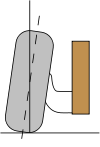- Camber angle
-
 The 1960 Milliken MX1 Camber Car showing a large negative camber.
The 1960 Milliken MX1 Camber Car showing a large negative camber.
Camber angle is the angle made by the wheels of a vehicle; specifically, it is the angle between the vertical axis of the wheels used for steering and the vertical axis of the vehicle when viewed from the front or rear. It is used in the design of steering and suspension. If the top of the wheel is farther out than the bottom (that is, away from the axle), it is called positive camber; if the bottom of the wheel is farther out than the top, it is called negative camber.
Camber angle alters the handling qualities of a particular suspension design; in particular, negative camber improves grip when cornering. This is because it places the tire at a better angle to the road, transmitting the forces through the vertical plane of the tire rather than through a shear force across it. Another reason for negative camber is that a rubber tire tends to roll on itself while cornering. Negative camber can also be caused by excessive weight on the front wheels. This is commonly seen on modified cars with larger engines than standard; the weight of the modified engine can make the wheels negatively camber. The inside edge of the contact patch would begin to lift off of the ground if the tire had zero camber, reducing the area of the contact patch. This effect is compensated for by applying negative camber, maximizing the contact patch area. Note that this is only true for the outside tire during the turn; the inside tire would benefit most from positive camber.
On the other hand, for maximum straight-line acceleration, the greatest traction will be attained when the camber angle is zero and the tread is flat on the road. Proper management of camber angle is a major factor in suspension design, and must incorporate not only idealized geometric models, but also real-life behavior of the components; flex, distortion, elasticity, etc. What was once an art has now become much more scientific with the use of computers, which can optimize all of the variables mathematically instead of relying on the designer's intuitive feel and experience. As a result, the handling of even low-priced automobiles has improved dramatically in recent years.
In cars with double wishbone suspensions, camber angle may be fixed or adjustable, but in MacPherson strut suspensions, it is normally fixed. The elimination of an available camber adjustment may reduce maintenance requirements, but if the car is lowered by use of shortened springs, the camber angle will change. Excessive camber angle can lead to increased tire wear and impaired handling. Significant suspension modifications may correspondingly require that the upper control arm or strut mounting points be altered to allow for some inward or outward movement, relative to longitudinal centerline of the vehicle, for camber adjustment. Aftermarket plates with slots for strut mounts instead of just holes are available for most of the commonly modified models of cars.
Off-road vehicles such as agricultural tractors generally use positive camber. In such vehicles, the positive camber angle helps to achieve a lower steering effort. Also, some single-engined general aviation aircraft that are primarily meant to operate from unimproved surfaces, such as bush planes and cropdusters, have their taildragger gear's main wheels equipped with positive-cambered main wheels to better handle the deflection of the landing gear, as the aircraft settles on rough, unpaved airstrips.
Contents
Road camber
In roads, an adverse camber refers to any road that tilts on the same side that a vehicle leans to on a road.[1] The term camber or cant refers to the way in which a road slopes from its centre. Usually on a right hand bend the road would slope downwards from left to right; this is known as a crossfall camber or cross slope — the opposite to an adverse camber.
See also
- Banked turn
- Camber thrust
- Cant (road/rail)
- Caster angle
- Kingpin (automotive part)
- Toe (automotive)
- Vehicle dynamics
- Chevrolet Corvair Handling
References
External links
Categories:- Automotive steering technologies
Wikimedia Foundation. 2010.

